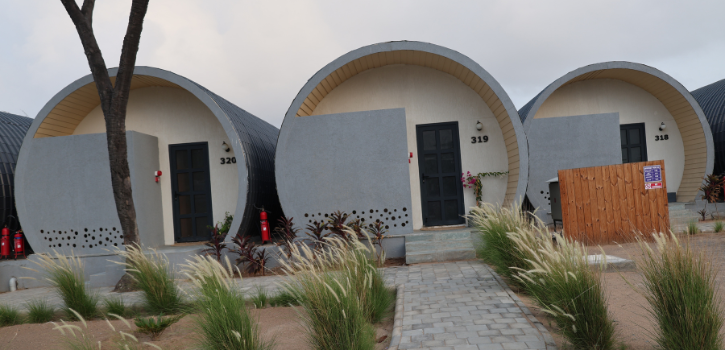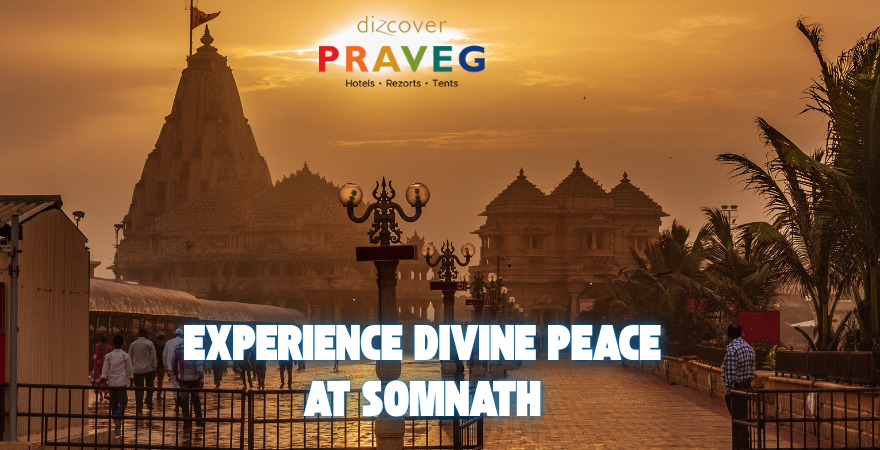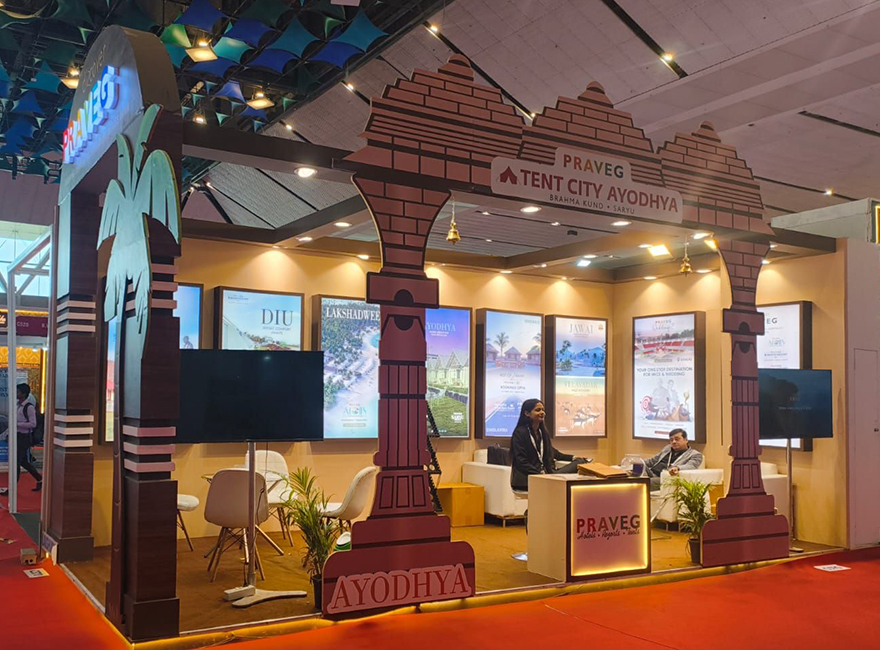Somnath stands proudly on the Saurashtra coast of Gujarat, where the waves of the Arabian Sea caress its golden stone. Changed by time and events, but more than an alluring geographical and spiritual destination. Somnath translates, according to legend, to God of the Moon, and long ago a temple was built in gold by Som (the Moon God) to regain his precious radiance after being cursed.
Although the period of its creation cannot be defined, history informs us of the temple's demise and resurrection on several occasions due to invasions. The temple was last rebuilt in 1951 when Sardar Vallabhbhai Patel envisioned remaking Somnath for future veneration. The temple was dedicated in 1951 and the new temple was completed in 1955 in Chalukya-style of architecture. The temple complex features one of the most intriguing structures, the Baan Stambh (Arrow Pillar). This standing stone pillar points in a continuous line to the South Pole, demonstrating Somnath's enduring relationship with infinity; literally without any land separation in the journey to the south. For travellers, not only does this provide the wonderful spiritual wonder, but another crazy unique geographical attraction.
Why Somnath Matters in Hindu Culture
Somnath is extremely important in Hindu culture. It is one of the twelve Jyotirlingas, the holiest places of Bhagwan Shiv. Pilgrims believe that by worshipping at Somnath, they will absolve themselves of their sins and attain their spiritual goals. The story of Somnath is originally told in the Rigveda and the Skanda Purana. The legend narrates Som’s devotion and the divine presence of Shiv. The Triveni Sangam is also located in Somnath, which bears sacred significance in Hinduism, as it is the confluence of three rivers: Kapila, Hiran, and Saraswati. Somnath is not only a religious place but also a representation of the endurance of the Hindu faith. The temple of Somnath has been rebuilt from destruction at least six times, which implies something more significant than a temple; it is a symbol of endurance in the fate of adversity, showing nothing can destroy their faith, thereby inspiring subsequent generations to persevere, or find strength and devotion to persevere through patterns of adversities.
What Can You Do at Somnath
Somnath offers a multitude of enriching activities for both devotees and explorers:
- Temple Visit: a feast for your eyes with delicately carved architecture and a range of experiences where you can feel the spiritual energy.
- Participate in Sacred Rituals: Observe or participate in the daily Aartis. The Aartis exude devotion songs and prayer that fill the temple. The temple practically vibrates when the evening Aarti is performed as the temple becomes alive with energy.
- Light & Sound Show: Attend the nightly light and sound show that gives a strong account of the mythological and historical story of Somnath. It's narrated by the famous baritone, telling of Amitabh Bachchan, and creates a mesmerizing atmosphere.
- Somnath Beach Stroll: Located right outside the temple, a beach walk on the shore will allow for peace, gazing at the sunrise or investing feelings while looking out into the bhagva.
- Triveni Sangam Dip: You are encouraged to take part in a dip there, as it is a confluence of rivers where a dip is auspicious.
Activities to Do
Apart from temple-centered pursuits, indulge in leisure and adventure:
- Camel and Horse Rides: Take a leisurely ride along the coast, which is excellent for families and children.
- Photography: Take pictures of the temple at sunrise and at sunset, with the Arabian Sea as a backdrop.
- Local Culinary Delights: Enjoy local snacks like roasted corn and bhel puri from a colourful beachside vendor.
- Meditation and Yoga: There is no better place to practice mindfulness than the sound of the ocean—many visitors meditate at the shore or in the temple gardens.
- Birdwatching: The coastline has migratory birds, making it a nugget of opportunity for nature lovers.
- Pilgrimage Trails: You can take your journey further by visiting other sacred sites like Bhalka Tirth (where Bhagwan Krishna departed the earthly body), Surya Mandir and Gita Mandir; each on their own layered with stories and spiritual meaning.
How to Reach Somnath from Diu
Somnath is quite close to Diu, approximately 80 km away, which allows for a day trip or overnight stay while visiting the region. Travel time is usually 2 to 2.5 hours.
- By Car/Taxi: This is the fastest and most comfortable method of travel. The long and scenic drives along the sometimes rugged Saurashtra coast make for a pleasant trip.
- By Bus: Public transport is operated by the Gujarat State Road Transport and private bus services and they provide regular services between Diu and Somnath which are ideal for budget travellers.
- By Train: The nearest railway station is Veraval (7 kms from Somnath Temple), which is well connected to all major cities in Gujarat. You can obtain local transport/taxis from Veraval to Somnath.
Accommodation: Praveg Beach Resort - Diu

For those seeking comfort with spiritual proximity, Praveg Beach Resort in Diu is a fantastic choice. Nestled by the serene coastline, the resort features elegant sea-facing rooms, private beach access, and a tranquil atmosphere that mirrors the divine peace of Somnath. Guests can unwind in well-appointed cottages, indulge in local cuisine, and easily venture to Somnath and Diu’s beaches or historical sites. The resort’s location offers both respite and convenience, allowing for effortless access to Somnath’s spiritual aura while basking in coastal beauty and leisure.
For travellers looking for comfort with spiritual closeness, Praveg Beach Resort is a good option because it is located in Diu. The resort is situated along the calm shore and offers delightful sea-facing rooms, private beach access, and a peaceful environment that is reminiscent of the spiritual peace that is experienced in Somnath. Visitors can relax in the comfortable cottages available, enjoy traditional cuisine, and get to Somnath and Diu's beaches or historical sites straight away. Given the resort's location, it provides a chance for relaxation and quick access to Somnath's spiritual teachings while relaxing on the coastline.
Conclusion
Visiting Somnath is not a journey but a divine pilgrimage. The reconstructed temple (1951-1955), the Lokatana to Baan Stambh eternal relationship, and the legends associated with this holy Jyotirlinga add an eternal nature of devotion in this holy place. Couple your pilgrimage with a soothing experience of stay at Praveg Beach Resort, Diu, for relaxation and rejuvenation while retaining divine peace near the sea.
Whether to fulfil wishes, seek the blessings of Lord Shiv, recreate peace near the ocean, or spend some time reminiscing or exploring some cultural respect, Somnath, and Diu in combination will provide experiences full of devotion, heritage, and renewal.







